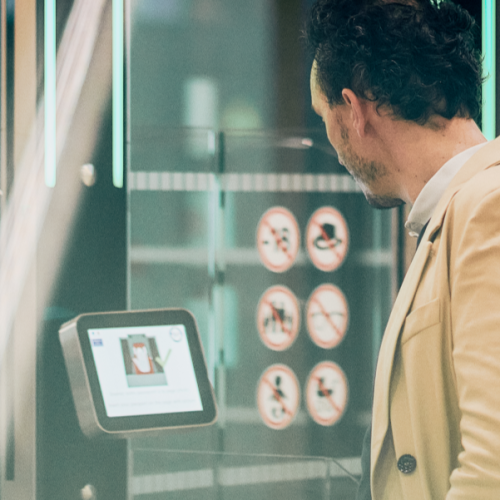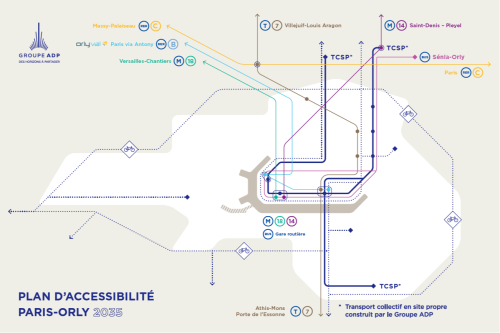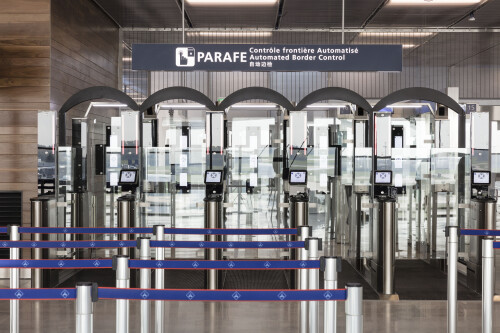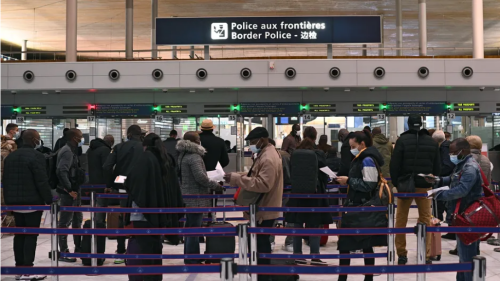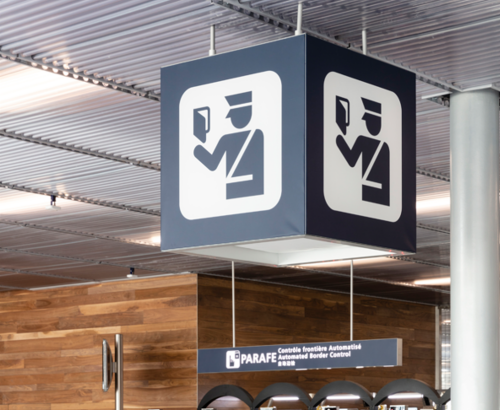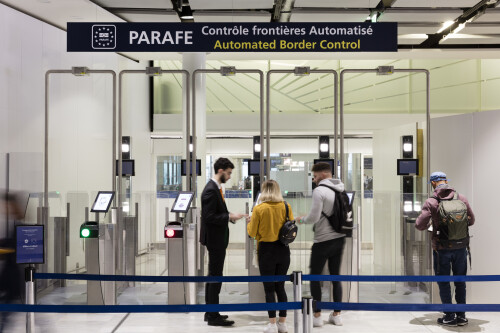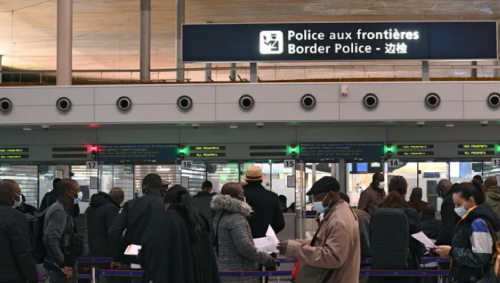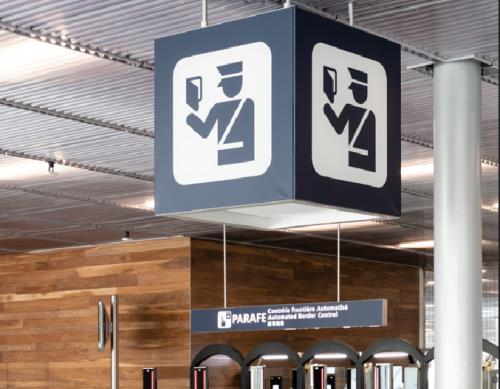The "Direction de la Police aux Frontières" (head of French Border Police) and Groupe ADP have joined forces to draw up a monthly report on the waiting times encountered by passengers at the various border control points at Paris-Charles de Gaulle and Paris-Orly Airports.
General trend observed in October 2023 [1] :
For the record, the maximum waiting times at the Border Police in airports, targeted by the French Prime Minister - during the inter-ministerial council on tourism on 26th July 2017 -, are 30 minutes for European nationals and 45 minutes for non-Europeans.
- At Paris-Charles de Gaulle: of nearly 2.7 million international passengers [2] 87.8% waited less than 10 minutes, 10.9% between 10 and 30 minutes, 1.1% between 30 and 45 minutes, and 0.2% more than 45 minutes.
- At Paris-Orly: of nearly 966,550 international passengers, 95.5% waited less than 10 minutes, 4.4% between 10 and 30 minutes, 0.1% between 30 and 45 minutes and less than 0.1% more than 45 minutes.
Events resulting in waiting times of over 30 minutes [3] :
At Paris-Charles de Gaulle /
Week 40: 30 events affecting around 9,900 passengers, with an average waiting time of 42 minutes.
Week 41: 21 events affecting around 4,600 passengers, with an average waiting time of 37 minutes.
Week 42: 25 events affecting around 6,600 passengers, with an average waiting time of 42 minutes.
Week 43: 27 events affecting around 8,000 passengers, with an average waiting time of 42 minutes.
At Paris-Orly /
Week 40: 2 events affecting around 220 passengers, with an average waiting time of 38 minutes.
Week 41: 3 events affecting around 320 passengers, with an average waiting time of 42 minutes.
Week 42: 5 events affecting around 400 passengers, with an average waiting time of 41 minutes.
Week 43: 2 events affecting around 200 passengers, with an average waiting time of 50 minutes. Note that the methodology does not include these two events in the overall monthly percentages for Paris-Orly, since they affected less than 0.05% of passengers, the final value used is 0.0%.
Flashbacks at some events:
- Thursday, October 5, arrivals at Terminal 2E, Paris-Charles de Gaulle, between 8:50 and 11:00 am. During this high-traffic period, police officers had to be mobilized for missions linked to the Rugby World Cup (welcoming and facilitating passengers, escorted movements on the platform...). A strategy of prioritizing departing flights was implemented by Groupe ADP teams, in collaboration with the Border Police, in order to guarantee the punctuality of flight schedules. As a result, some 900 customers waited until 1 a.m. for arrivals.
- Sunday October 8, arrivals at Paris-Charles de Gaulle Terminal 2E, from 6.55am to 8.40am. A particularly heavy flow of passengers through the PARAFE airlocks led teams to redirect some passengers to the classic aubette lines. Some 1,200 passengers waited up to 45 minutes. Paris Airport teams broadcast audio announcements explaining the slowdown, and additional hosts and hostesses were mobilized to assist the most vulnerable customers.
- On Monday 16 October, departures from Terminal 1 at Paris-Charles de Gaulle, between 7.55pm and 9.25pm. The Border Police has been mobilised for a number of regalian missions in the early evening, which had an impact on the number of police officers available for border control and did not allow the PARAFE airlocks to be opened (one police officer to supervise the opening of 5 PARAFE airlocks). Around 170 passengers waited up to 70 minutes.
- On Thursday October 19, between 9:25 and 10:05 am, departures from Terminal 1 at Paris-Charles de Gaulle were subject to a national breakdown in the computer files used by the Border Police. As a result, aubette controls had to be interrupted, and only the PARAFE airlocks could be used by eligible passengers. Substantial reinforcements of border guards were mobilized to carry out the controls manually, thus limiting the impact: some 800 passengers waited up to 1 hour. Audible announcements were broadcast to explain the situation to passengers.
|
PARAFE airlocks densification program continues at Paris-Charles de Gaulle Work is currently underway in the Terminal 2E departures border control area, to increase the number of PARAFE airlocks from 15 to 18. These will be operational by the end of the year, and will boost resources for the winter festive season. The aim is to offer 170 airlocks by summer 2024 (+39% compared with 2023). |
Details of monthly results for October 2023 regarding Paris-Charles de Gaulle and Paris-Orly:
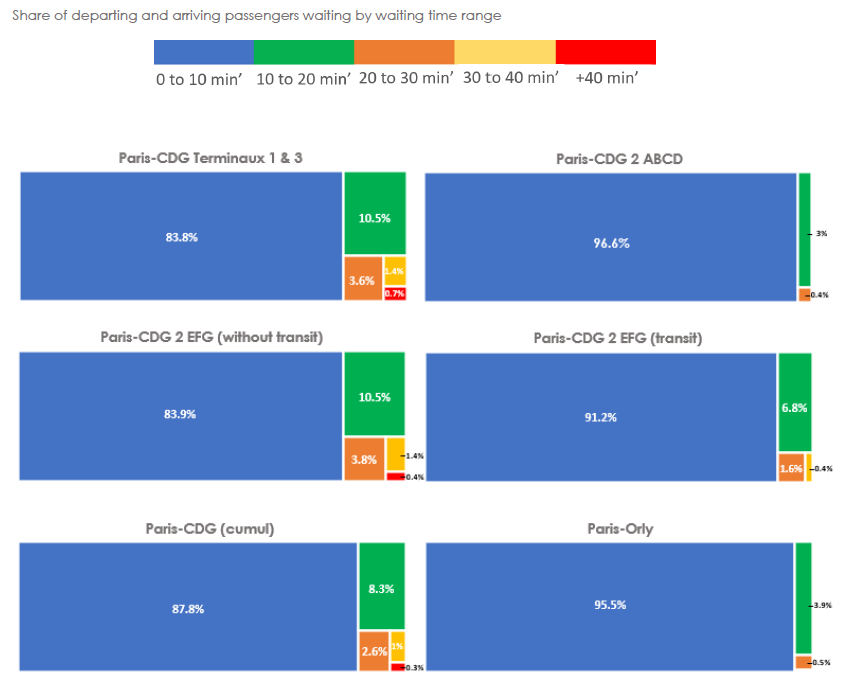
Methodology: real time data from counting sensors
Since 2019, Groupe ADP has deployed tools to monitor and control passenger flows and waiting times. In particular, sensors allowing the number of passengers to be counted in real time in a queue have been deployed to equip the border crossing and safety control areas of Paris Airports.
This is a real-time measurement tool that is automatically updated every five seconds. It counts the number of passengers in a queue by measuring how long the last person to leave the queue has been waiting. Between 80 and 200 sensors are needed to cover an area, depending on its size.
The data is fed into an operational performance monitoring tool that analyses what has happened in an operational day. It is the data extracted from these sensors that is used to set up this barometer.
___________________________________
[1] In September 2023: at Paris-Charles de Gaulle, out of 4 million international passengers, 86.5% waited less than 10 minutes, 98.7% less than 30 minutes and 99.8% less than 45 minutes. At Paris-Orly, out of almost 1.2 million international passengers, 92.1% waited less than 10 minutes, 99.8% less than 30 minutes and 100% less than 45 minutes;
[2] Included are passengers who crossed a border on departure, transfer or arrival at Paris-Charles de Gaulle or Paris-Orly (not including passengers on domestic or Schengen flights).
[3] Events impacting more than 50 passengers per calendar week are included. Two occurrences must be separated by 20 minutes, otherwise only one event is counted.








